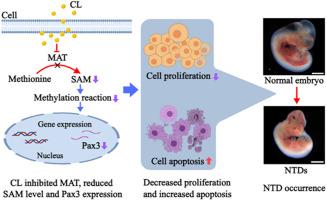环亮氨酸会降低 Pax3 的表达,并损害早期神经形成过程中增殖和凋亡的平衡,从而诱发神经管缺陷。
IF 4.4
3区 医学
Q2 BIOCHEMISTRY & MOLECULAR BIOLOGY
引用次数: 0
摘要
S- 腺苷蛋氨酸(SAM)在神经管畸形(NTD)的发育过程中起着至关重要的作用。研究表明,配对盒 3(Pax3)基因参与了神经管闭合。然而,Pax3与SAM缺乏诱导的NTD之间的确切机制仍不清楚。在此,我们使用SAM生物合成抑制剂环亮氨酸(CL)诱导了NTD小鼠模型,以确定Pax3对NTD的影响。在NTD胚胎脑组织和永生化海马神经元细胞(HT-22)中,通过5-乙炔基-2'-脱氧尿苷(EdU)染色、免疫组化、末端脱氧核苷酸转移酶介导的dUTP缺口标记(TUNEL)、实时定量反转录聚合酶链反应(qRT-PCR)和Western印迹等方法评估了CL对NTD发生的影响。当 CL 的剂量为 200 毫克/千克体重时,NTD 的发生率很高。接触 CL 后,NTD 胚胎脑组织和 HT-22 细胞中的 SAM 和 Pax3 水平显著降低。在 SAM 缺乏的情况下,NTD 胚胎和 HT-22 细胞的神经上皮细胞出现增殖减少和过度凋亡,但过表达 Pax3 可逆转这些影响。这些结果表明,Pax3表达减少会破坏细胞增殖和凋亡之间的动态平衡,从而导致SAM缺乏诱导的NTD,这将为阐明NTD的内在机制提供新的见解。本文章由计算机程序翻译,如有差异,请以英文原文为准。

Cycloleucine induces neural tube defects by reducing Pax3 expression and impairing the balance of proliferation and apoptosis in early neurulation
S-adenosylmethionine (SAM) plays a critical role in the development of neural tube defects (NTDs). Studies have shown that the paired box 3 (Pax3) gene is involved in neural tube closure. However, the exact mechanism between Pax3 and NTDs induced by SAM deficiency remains unclear. Here, The NTD mouse model was induced using cycloleucine (CL), an inhibitor of SAM biosynthesis, to determine the effect of Pax3 on NTDs. The effect of CL on NTD occurrence was assessed by 5-ethynyl-2′-deoxyuridine (EdU) staining, immunohistochemistry, terminal deoxynucleotidyl transferase-mediated dUTP nick end labeling (TUNEL), quantitative real-time reverse transcription polymerase chain reaction (qRT-PCR), and Western blot in NTD embryonic brain tissues and immortalized hippocampal neuron cells (HT-22). A high incidence of NTDs was observed when CL was administered at a dose of 200 mg/kg body weight. The levels of SAM and Pax3 were significantly reduced in NTD embryonic brain tissues and HT-22 cells after CL exposure. Decreased proliferation and excessive apoptosis were observed in neuroepithelial cells of NTD embryos and HT-22 cells under SAM deficiency, but these effects were reversed by overexpression of Pax3. These results suggest that decreased expression of Pax3 impairs the dynamic balance between cellular proliferation and apoptosis, contributing to NTDs induced by SAM deficiency, which would provide new insights for clarifying the underlying mechanism of NTDs.
求助全文
通过发布文献求助,成功后即可免费获取论文全文。
去求助
来源期刊

Neurochemistry international
医学-神经科学
CiteScore
8.40
自引率
2.40%
发文量
128
审稿时长
37 days
期刊介绍:
Neurochemistry International is devoted to the rapid publication of outstanding original articles and timely reviews in neurochemistry. Manuscripts on a broad range of topics will be considered, including molecular and cellular neurochemistry, neuropharmacology and genetic aspects of CNS function, neuroimmunology, metabolism as well as the neurochemistry of neurological and psychiatric disorders of the CNS.
 求助内容:
求助内容: 应助结果提醒方式:
应助结果提醒方式:


